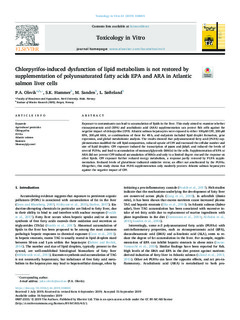Chlorpyrifos-induced dysfunction of lipid metabolism is not restored by supplementation of polyunsaturated fatty acids EPA and ARA in Atlantic salmon liver cells
Journal article, Peer reviewed
Published version
Permanent lenke
http://hdl.handle.net/11250/2639988Utgivelsesdato
2019Metadata
Vis full innførselSamlinger
- Articles [3012]
- Publikasjoner fra CRIStin [3070]
Sammendrag
Exposure to contaminants can lead to accumulation of lipids in the liver. This study aimed to examine whether eicosapentaenoic acid (EPA) and arachidonic acid (ARA) supplementation can protect fish cells against the negative impact of chlorpyrifos (CPF). Atlantic salmon hepatocytes were exposed to either 100 μM CPF, 200 μM EPA, 200 μM ARA, or combinations of these for 48 h, and endpoints included lipid droplet formation, gene expression, and global metabolomic analysis. The results showed that polyunsaturated fatty acid (PUFA) supplementation modified the cell lipid composition, reduced uptake of CPF and increased the cellular number and size of lipid droplets. CPF exposure induced the transcription of ppara and fabp3, and reduced the levels of several PUFAs, and lead to accumulation of monoacylglycerols (MAGs) in the cells. Supplementation of EPA or ARA did not prevent CPF-induced accumulation of MAGs and only to a limited degree rescued the response on other lipids. CPF exposure further reduced energy metabolism, a response partly restored by PUFA supplementation. Reduced levels of glutathione indicated oxidative stress; an effect not ameliorated by the PUFAs. Altogether, this study shows that PUFA supplementation only modestly protects Atlantic salmon hepatocytes against the negative impact of CPF.
